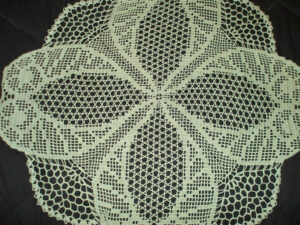As I have mentioned in a previous post, I had been taught how to crochet at an early age by one of my aunts. I learned the chain stitch (ch st) and the double crochet (dc), and how to make a potholder.
And that was all my aunt knew. Being inquisitive, and bored (mostly bored) of making the same item over and over again, I purchased a crochet magazine that had detailed instructions with pictures (There was no YouTube, or video’s of any kind back then!), on many different types of crochet stitches and techniques. I would sit in my room for hours painstakingly turning the pages from the pattern I had chosen to the back of the magazine to read how to make the stitch. Understanding the different abbreviations was also something that took time. But before I knew it I was making doilies with the same #10 cotton crochet thread and #7 steel crochet hook my aunt had taught me to crochet with. Because I am not very good with a needle and thread, most of my creations were one-piece items. The bigger the better! My signature pattern became a 28in diameter doily (see the picture of the red doily in the gallery). Still thinking of myself as a beginner and not very talented, I hesitated to give my aunt one of these doilies. We are talking about 10 years have passed since she had seen anything I had made. I was totally surprised and not prepared for her reaction. She held the doily and just kept moving it around looking at the lacy part and remarking how beautiful, and how she could never make anything so intricate. I couldn’t understand why not, she was looking at the same two stitches she had taught me so many years before! I told her that as well. I said this is made of chain stitches and double crochet! Now mind you, I had forgotten that my aunt, when teaching me how to start the potholder, recited to me how many chains stitches to make to create the foundation row. Then she told me how many double crochets, and chain stitches for the complete potholder. If there was a pattern for it, it was memorized and maybe notes written down somewhere in her project basket. I never saw one.
I did not realize at the time, that those hours and hours flipping those pages back and forth would become the start of a passion to create something from cotton thread or yarn and a hook that would stay with me for my entire life! It also gave me the confidence to choose more challenging projects like the second doily, and the afghans you see pictured here in my gallery. I also did not realize that because I had learned all the abbreviations to those stitches, I had learned to read a whole new language. The patterns that I have made, had they been written in longhand, would take pages upon pages just to write out a few rows. Take the following sentence as an example,
Ch 88. Dc in 4th ch from HK. Dc in ea st to end.
Translation: Chain 88. Double Crochet in the fourth chain from hook. Double crochet in each stitch to end.
The more I kept up at this the more I learned about the shortcuts, and tips on reading this now very familiar language. I have been able to help a few people learn this craft of crocheting when they had given up trying. The actual art of crochet is awkward at first, but as with anything, given time, it becomes easy. The following of a pattern is just downright frustrating period. But when a person sits by and translates, as they are learning, a whole new world opens up.
Looking back now I can see other areas of my life that crocheting has benefitted me. I am now able to “translate” for customers that may be confused about a product they want to buy. Whether how to use it, or what the purpose of the product is for. Recently, I had held a position as a sales associate in an electronics dept of a big box store. When a customer came in to buy a modem/router that her cable company advised her she would need. She had wanted to save money on her cable bill and decided she didn’t want to pay the rental fee on a converter box. So the company advised her to come in and buy one. She had no idea what she was buying, to the point where she had written down what the cable salesperson told her.
I asked if she knew what that was and why she needed it. She was not prepared for the cost of this item. Knowing that if I told her the technical terms of what this was for, she would only get frustrated and that is not how I treat my customers. So, I simply said, “the modem part of this team is kind of like a receiving clerk. It receives (or draws in) the internet into your home. And the router is the traffic director who directs the internet to all the devices in your home…like your smartphones and televisions.
When there are work situations or certain times in my life that I find myself struggling with something, I have been able to step back, take a deep breath, and look at whatever it might be as just another challenge to push through.



